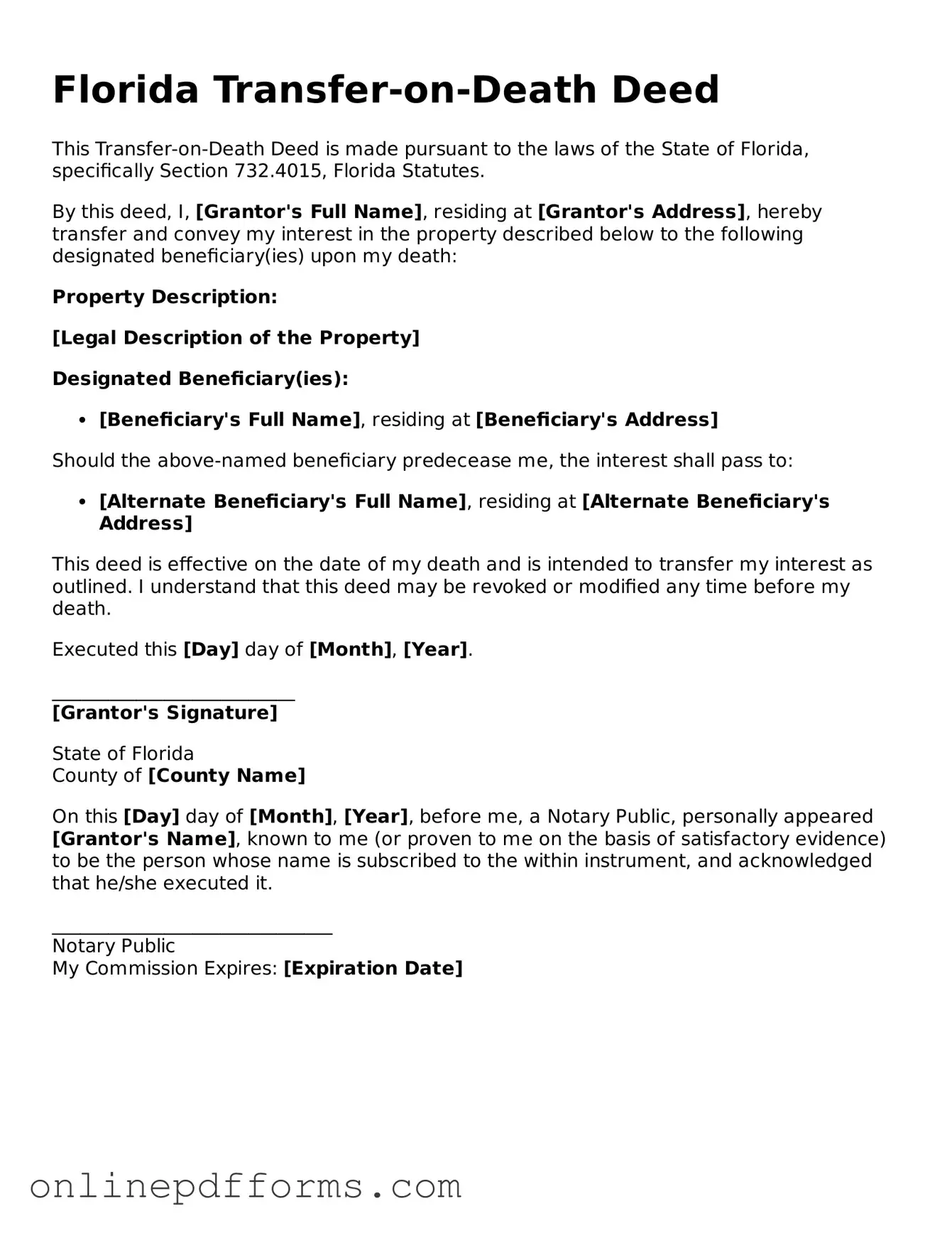The Florida Transfer-on-Death Deed (TODD) is similar to a Last Will and Testament in that both documents allow individuals to dictate the distribution of their property after their death. A will requires probate, a legal process that validates the document and oversees the distribution of assets. In contrast, a TODD bypasses probate, allowing for a more straightforward transfer of property directly to the named beneficiaries upon the owner's death. This feature can simplify the estate settlement process and reduce associated costs.
Another document comparable to the TODD is a Revocable Living Trust. Like the TODD, a revocable living trust facilitates the transfer of assets outside of probate. However, a living trust allows the creator to maintain control over the assets during their lifetime, with the ability to amend or revoke the trust as circumstances change. Upon the creator's death, the assets within the trust are distributed according to the terms set forth in the trust document, making it a flexible estate planning tool.
The TODD also shares similarities with a Beneficiary Designation form, often used for financial accounts such as bank accounts or retirement plans. Both documents allow individuals to name beneficiaries who will receive assets upon their death. However, while beneficiary designations are limited to specific accounts and financial assets, the TODD applies to real property, making it a unique option for real estate transfers.
A Joint Tenancy with Right of Survivorship agreement is another document that parallels the TODD. This arrangement allows two or more individuals to hold title to property jointly, with the surviving owner(s) automatically inheriting the deceased owner's share upon death. While both documents facilitate the transfer of property without probate, a joint tenancy requires all parties to be involved in the ownership during the owner's lifetime, whereas a TODD allows the original owner to retain full control until death.
The TODD is also akin to a Life Estate Deed, which grants an individual the right to use and occupy a property during their lifetime, with the property passing to another party upon their death. Both documents provide a means of transferring property while retaining certain rights during the owner's life. However, a life estate deed typically involves more complex rights and responsibilities, including maintenance and tax obligations, which are not present in a straightforward TODD.
Another similar document is the Power of Attorney, which allows individuals to designate someone to make decisions on their behalf while they are alive. Although a power of attorney ceases upon the principal's death, it can be used to manage real estate and other assets before death. While the TODD is focused on transferring property after death, the power of attorney can play a crucial role in managing those assets during the owner's lifetime.
The TODD can also be compared to a Quitclaim Deed. A quitclaim deed transfers ownership of property from one party to another without warranties. While both documents facilitate property transfer, a quitclaim deed is often used for immediate transfers and does not have the same provisions for posthumous transfers as a TODD. The quitclaim deed does not provide the same level of clarity regarding the intent to transfer property upon death.
Additionally, a Family Settlement Agreement can be seen as similar to the TODD in that it addresses the distribution of assets among family members. Such agreements are typically reached after a death and can help resolve disputes regarding property distribution. However, unlike the TODD, which allows for a clear and direct transfer of property before death, a family settlement agreement often arises from the complexities of probate and the need to negotiate among heirs.
If you are dealing with the legalities of vehicle transactions in Texas, it’s important to have the correct documentation, such as the Texas Motor Vehicle Power of Attorney form. This document allows individuals to manage vehicle-related matters on behalf of others, which can be particularly useful for those unable to attend to these affairs personally. For further details, you can visit pdftemplates.info/texas-motor-vehicle-power-of-attorney-form.
The TODD also resembles a Deed of Gift, which is used to transfer property as a gift during the owner's lifetime. Both documents facilitate the transfer of property; however, a deed of gift is irrevocable, meaning once the property is transferred, the original owner cannot reclaim it. In contrast, the TODD allows the owner to retain control of the property until death, providing flexibility in estate planning.
Finally, the TODD is similar to an Affidavit of Heirship, which is a legal document that establishes the heirs of a deceased individual. While an affidavit of heirship is typically used to clarify ownership and facilitate the transfer of property after death, it does not provide the same proactive approach as a TODD, which allows the property owner to designate beneficiaries in advance, thereby simplifying the transfer process.
